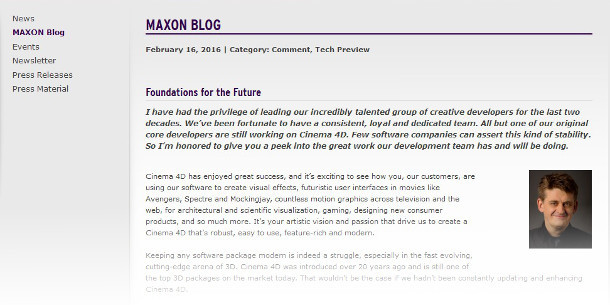Maxon working on new core architecture for Cinema 4D
Maxon is working on a new core architecture for Cinema 4D, the company has announced on its blog. The transition to the new architecture began with Cinema 4D R16 and will continue in future releases.
A replacement for Cinema 4D’s 16-year-old core architecture
According to Maxon co-founder and CTO Harald Schneider, the new core architecture will replace the one originally introduced with Cinema 4D XL V6, back in 2000.
Benefits of the new architecture include “a highly efficient threading system for massive data-parallelism and new optimized data structures”.
The new core is modular, and is being phased in gradually. The first phase of integration came with Cinema 4D R16, released in 2014, and the process will continue for “several more releases”.
“While new developments are based on the new core, existing functionality continues to work seamlessly and will become even more powerful once it’s transitioned natively to the new architecture,” writes Schneider.
Other than that, the blog post doesn’t go into a lot of detail about the new architecture: there’s no information on how Cinema 4D R16 and R17 made use of it, for example.
A similar process to other 3D applications
In some ways, the real surprise is not that Maxon is working on a new architecture, but that it’s taken so long to talk about it.
Autodesk went through a similar process with Project Excalibur, its under-the-hood rewrite of 3ds Max, which began with 3ds Max 2010 and also rolled out across the course of several releases.
NewTek is also currently doing the same thing, a process it has been discussing in its blog posts about the still officially unnamed forthcoming update to LightWave.
In the blog post, Schneider comments that Maxon has progressed “deliberately and … quietly” to give the development team “space to … consider the best path for the future”.
But why talk about it now?
Which still begs the question, ‘Why announce it now?’
An uncharitable interpretation would be that it’s a response to the lukewarm reception last year’s Cinema 4D R17 received from some long-term users.
A more charitable one would just be that Maxon now has a place to discuss these things: the company launched the blog last year with the stated aim of talking about future development plans.
Either way, with the cat out of the bag, we’d expect to see Maxon discussing the new architecture in more detail in future releases of Cinema 4D.
Read Harald Schneider’s post about Cinema 4D’s new core architecture on Maxon’s blog

